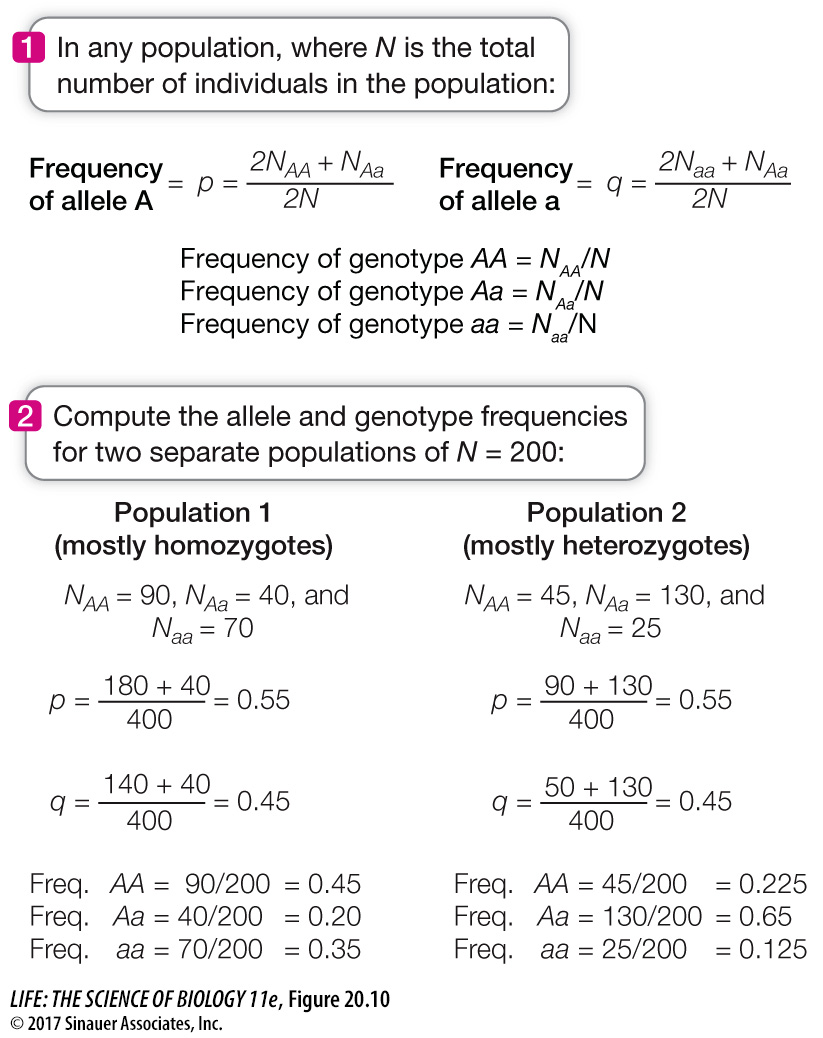key concept
20.3
Evolution Can Be Measured by Changes in Allele Frequencies
key concept
20.3
Evolution Can Be Measured by Changes in Allele Frequencies
Much of evolution occurs through gradual changes in the relative frequencies of different alleles in a population from one generation to the next. Major genetic changes can also be sudden, as happens when two formerly separated populations merge and hybridize, or when genes within a population are duplicated within the genome. But in most cases, we measure evolution by looking at changes in allele and genotype frequencies in populations over time.
focus your learning
Biologists detect and measure evolutionary changes in populations by calculating changes in allele frequencies over time.
The evolutionary processes acting on a population can be identified using Hardy−Weinberg equilibrium as a basis for calculations.
To measure allele frequencies in a population precisely, we would need to count every allele at every locus in every individual in the population. Fortunately, we do not need to make such complete measurements because we can reliably estimate allele frequencies for a given locus by counting alleles in a sample of individuals from the population. The sum of all allele frequencies at a locus is equal to 1, so measures of allele frequency range from 0 to 1.
An allele’s frequency is calculated using the following formula:

If only two alleles (we’ll call them A and a) for a given locus are found among the members of a diploid population, those alleles can combine to form three different genotypes: AA, Aa, and aa. A population with more than one allele at a locus is said to be polymorphic (“many forms”) at that locus. Applying the formula above, as shown in Figure 20.10, we can calculate the relative frequencies of alleles A and a in a population of N individuals as follows:
Let NAA be the number that are homozygous for the A allele (AA).
Let NAa be the number that are heterozygous (Aa).
Let Naa be the number that are homozygous for the a allele (aa).
research tools
Figure 20.10 Calculating Allele and Genotype Frequencies Allele and genotype frequencies for a gene locus with two alleles in the population can be calculated using the equations in panel 1. When the equations are applied to two populations (panel 2), we find that the frequencies of alleles A and a in the two populations are the same, but the alleles are distributed differently between heterozygous and homozygous genotypes.

Note that NAA + NAa + Naa = N, the total number of individuals in the population, and that the total number of copies of both alleles present in the population is 2N, because each individual is diploid. Each AA individual has two copies of the A allele, and each Aa individual has one copy of the A allele. Therefore the total number of A alleles in the population is 2NAA + NAa. Similarly, the total number of a alleles in the population is 2Naa + NAa. If p represents the frequency of A, and q represents the frequency of a, then

and

The calculations in Figure 20.10 demonstrate two important points. First, notice that for each population, p + q = 1, which means that q = 1 – p. So when there are only two alleles at a given locus in a population, we can calculate the frequency of one allele and obtain the second allele’s frequency by subtraction. If there is only one allele at a given locus in a population, its frequency is 1: the population is then monomorphic at that locus, and the allele is said to be fixed.
Second, notice that population 1 (consisting mostly of homozygotes) and population 2 (consisting mostly of heterozygotes) have the same allele frequencies for A and a. Thus they have the same gene pool for this locus. Because the alleles in the gene pool are distributed differently among individuals, however, the genotype frequencies of the two populations differ.
The frequencies of the different alleles at each locus and the frequencies of the different genotypes in a population describe that population’s genetic structure. Allele frequencies measure the amount of genetic variation in a population, whereas genotype frequencies show how a population’s genetic variation is distributed among its members. Other measures, such as the proportion of loci that are polymorphic, are also used to measure variation in populations. With these measurements, it becomes possible to consider how the genetic structure of a population changes or remains the same over generations—